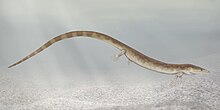| Urocordylidae Temporal range: Late Carboniferous
| |
|---|---|

| |
| Life restoration of Sauropleura pectinata | |
| Scientific classification | |
| Domain: | Eukaryota |
| Kingdom: | Animalia |
| Phylum: | Chordata |
| Clade: | Sarcopterygii |
| Clade: | Tetrapodomorpha |
| Order: | †Nectridea |
| Family: | †Urocordylidae Lydekker, 1889 |
| Subfamilies | |
The Urocordylidae are an extinct family of nectridean lepospondyl amphibians. Urocordylids lived during the Late Carboniferous and Early Permian in what is now Europe and North America and are characterized by their very long, paddle-like tails. In life, they were probably newt-like and aquatic.[1]
Fossils have been found from Ireland, France, and the eastern United States. The family was named by English naturalist Richard Lydekker in 1889 and includes the well-known genera Urocordylus and Sauropleura, as well as several others based on less-complete material.[2] The family Urocordylidae is divided into two subfamilies, the Urocordylinae and the Sauropleurinae. The two groups are distinguished by the shapes of their skulls; urocordylines have short, blunt skulls, and sauropleurines have longer, pointed skulls.[3]
- ^ Carroll, R.L.; Bossy, K.A.; Milner, A.C.; Andrews, S.M.; Wellstead, C.F. (1998). "Lepospondyli". In P. Wellnhofer (ed.). Handbuch der Paläoherpetologie. Vol. 1. Munich: Verlag Dr. Friedrich Pfeil. p. 216. ISBN 978-3-931516-26-0.
- ^ Marcello Ruta, Michael I. Coates and Donald L. J. Quicke (2003). "Early tetrapod relationships revisited" (PDF). Biological Reviews. 78 (2): 251–345. doi:10.1017/S1464793102006103. PMID 12803423.
- ^ Carlson, K. J. (1999). "Crossotelos, an Early Permian nectridian amphibian". Journal of Vertebrate Paleontology. 19 (4): 623–631. doi:10.1080/02724634.1999.10011176.